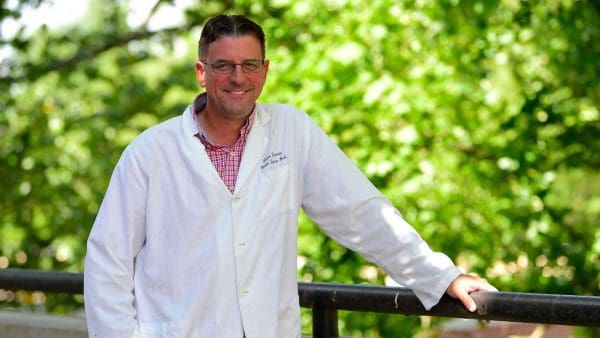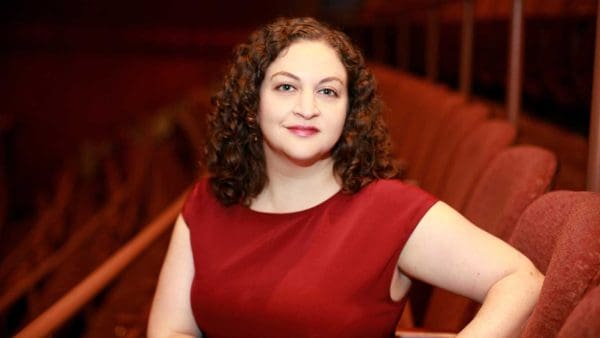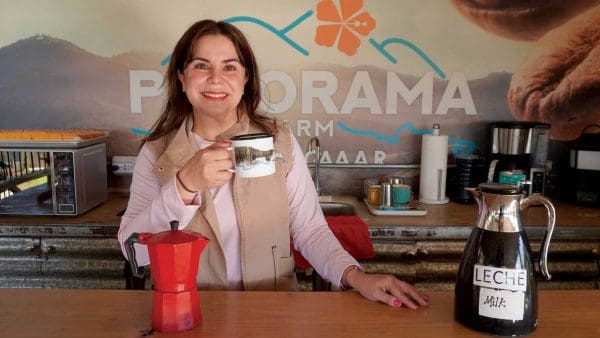More than a few magical creatures inhabit the equally magical Cloisters Museum and Gardens on the northern tip of Manhattan. Monkeys spring from carved columns, unicorns glow on dark tapestries in even darker rooms, a lion glowers from a fresco. Then there’s the dragon coiled on the brass belt buckle shining at the waist of C. Griffith Mann ’02 (PhD), the Michel David-Weill Curator in Charge of the Department of Medieval Art and The Cloisters at The Metropolitan Museum of Art. Mann, who goes by the nickname Griff, may sport sartorial whimsy (he’s also fond of bow ties and patterned socks), but he’s very serious about his mission at the Met: to present the museum’s collection in both exciting and accessible ways that make the medieval world come alive for visitors or, as he puts it, “to open up a window into a world that is much more complicated and engaging than most people imagine.”
“We tend to have this sense about the medieval world, that it’s the Dark Ages and people were walking around in burlap sacks and there was plague and disease, and somehow it was always dark and rainy,” says Mann, who received his doctorate in history of art from the Krieger School. Instead, he points out, the medieval period was one of tremendous creativity, trade, and innovation. The Middle Ages witnessed the rise of the first universities and the building of magnificent cathedrals, where much of the era’s art was displayed and used as a primary means of communication with an audience that was illiterate. “These paintings and other objects are now collected as works of art,” explains Mann. “But when they were made, their primary function was something very different, something that was not solely aesthetic. Medieval art was embedded in people’s lives in a way I’ve always found very exciting,” he says.
Mann joined the Met in September 2013 after six years as deputy director and chief curator of the Cleveland Museum of Art. Prior to that, he was director of the curatorial division of the Walters Art Museum in Baltimore, a continuation of some of the work he did there as the first Zanvyl Krieger Fellow. “Working half time on my dissertation project and half time at the museum had a profound influence not only on my research but on my trajectory as well,” explains Mann, who says he was drawn to study at Hopkins by the art history department’s international reputation as an intellectual stronghold for study in medieval and Renaissance art. “The program was—and still is—incredibly rigorous, and the education I received has benefited me in my professional life.”
At the Met, Mann divides his time between the main building, which displays medieval art within the broader context of an encyclopedic collection, and The Cloisters, which presents part of the museum’s collection from the western European Middle Ages in an environment that evokes an ecclesiastical or monastic setting. While the role of a curator at many institutions has changed and expanded in the 20 years since Mann began his career, the size of the Met’s collections (roughly 14,000 objects make up both locations’ total medieval holdings), in addition to its annual 6 million visitors, adds to the position’s challenges. In addition to maintaining, growing, and displaying a collection, says Mann, a curator must be a scholar, a fundraiser, and perhaps most importantly, a teacher.
“My goal is to get people to find a way of connecting to something that at first might seem really esoteric or distant,” he explains. In addition to making those connections through curated exhibits like the recent Radiant Light: Stained Glass from Canterbury Cathedral at the Cloisters, Mann and other curators at the Met are turning to various technologies to help them tell the stories of their collections, such as the Met’s video series called 82nd & Fifth.
Making videos of medieval art doesn’t feel like a stretch for Mann, who explains that “medieval art is a multimedia experience” in Terrible Beauty, the video he recorded for the series. His topic: an altarpiece panel of the Archangel Michael casting Satan—here embodied as a fabulous beast made up of bits of many bizarre creatures including bird claws, lizards, and random eyeballs—down from heaven. The painting would have originally been in a church where the full array of incense, music, and prayer would have added a sensory context to the painting’s celebration of the triumph of good over evil. “As a museum curator, one of the opportunities—and responsibilities—you have is to find ways of opening windows onto material that you yourself find fascinating and are passionate about,” says Mann. “And I was fascinated with that incredible beast. I think something like that connects you with the fertile possibilities of the human imagination.”
Mann at the Met: “My goal is to get people to find a way of connecting to something that at first might seem really esoteric or distant,” he says. [Photo: Will Kirk/Homewoodphoto.jhu.edu]





